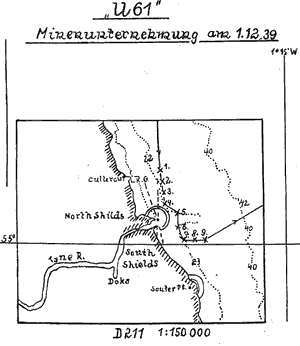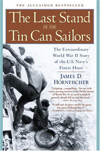Technologies
Mines
The submarine mine during World War Two was a very efficient and dangerous weapon if properly used. Minesweeping was expensive and time-consuming for the defenders, diverting materiél from other duties.
In the period prior to WWII the German Navy developed in secrecy a series of mines that were much superior to those used in the previous conflict. They were laid in hundreds of operations although Dönitz did not favor them as they were not quite as effective as the torpedo.

A type TMB mine being loaded on the U-373 in 1942.
Types of mines used
TMA was a big submarine floating mine. It was redesigned as the TMC in late 1939.
TMB was designed especially for submarine use. This was an unearthed "seabed" that utilized a magnetic pistol. It was 7.5 feet long and carried an explosive charge of 1,276 pounds (567kg) which was twice that of the torpedoes of the time. It was laid on the bottom in shallow seaways and was detonated when a big ship passed over its position. Not many ships survived such a blast under their keel.
The mines were originally laid at the depth of 30m but after reliability questions and testing it was established that 25m was much more lethal depth. The mines were also overly sensitive, sinking smaller ships than intended. The U-boat crews thus started laying them in even shallower waters and de-magnetizing them to reduce their sensitivity. This improved their score.
TMC was a ground variant of the floating TMA mine. It was designed after Dönitz' worries that the 1,276 pound warhead of the TMB might not be powerful enough against really big ships, like British battleships and aircraft carriers. Unlike the torpedo directorate that acted super-slow on reliability complaints the mine designers were quite willing to imporove their work. They delivered the TMC with a massive explosive charge of 2,200 pounds believed to be lethal of up to depth of 36 meters.
This mine was probably used for the first time by U-32 in Firth of Clyde in December 1939. They were laid in a unfavorable position and failed, the commander being sacked for disobeying orders.
SMC - I have very little information on this type of mine except that it was believed to be unsuited for U-boat operations.
Mine laying operations
Mine laying could be extremely effective but it was not a popular task for the U-boat crews. Traditionally the mines were laid close to shore in very hostile waters where, if discovered, the boat was in great danger of being destroyed. Another thing was that mines did not cause any immediate damage to shipping and thus was often not credited fairly and did not give the men any feeling of achievement like torpedoes did. Many of the men also felt this was somehow "sneaky" or unfair.
The exact position of the minefield had to be charted as accurately as possible. International laws required that minefield could be located and cleared after end of hostilities and the navy laying the field could be interested in extending it thus the plotting of its position was vital.
 This is an illustration of the minefield laid by U-61 off Newcastle on 1 Dec, 1939. It damaged the British merchant Gryfevale on the 22nd.
This is an illustration of the minefield laid by U-61 off Newcastle on 1 Dec, 1939. It damaged the British merchant Gryfevale on the 22nd.
When planting the mines they had a delayed-action time fuse which would not activate until the boat was clear of the area.
One class of U-boats were designed as mine-layers, the Type XB boats.



